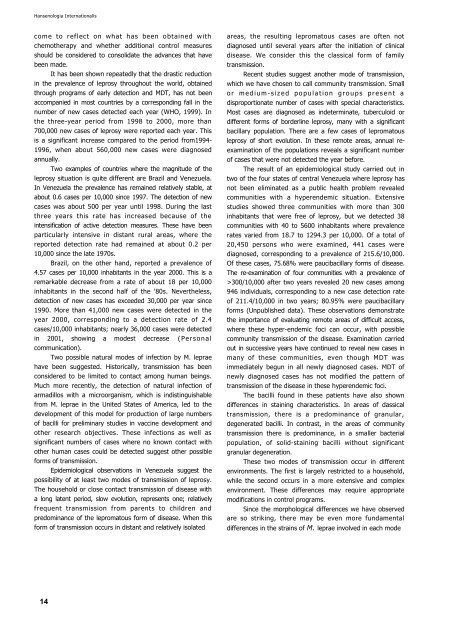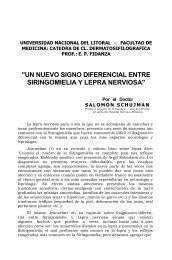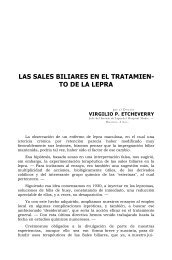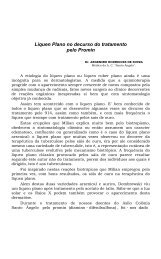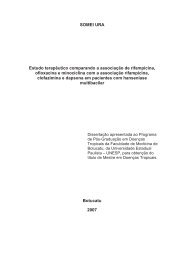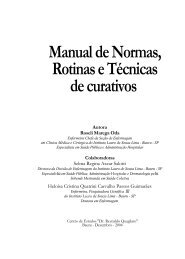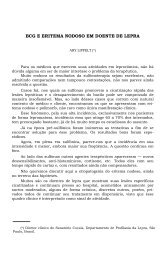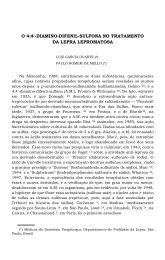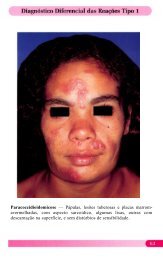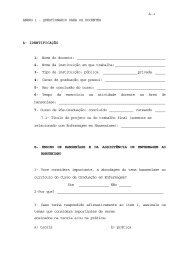Leprosy vaccines
Leprosy vaccines
Leprosy vaccines
Create successful ePaper yourself
Turn your PDF publications into a flip-book with our unique Google optimized e-Paper software.
Hansenologia Internationalis<br />
come to reflect on what has been obtained with<br />
chemotherapy and whether additional control measures<br />
should be considered to consolidate the advances that have<br />
been made.<br />
It has been shown repeatedly that the drastic reduction<br />
in the prevalence of leprosy throughout the world, obtained<br />
through programs of early detection and MDT, has not been<br />
accompanied in most countries by a corresponding fall in the<br />
number of new cases detected each year (WHO, 1999). In<br />
the three-year period from 1998 to 2000, more than<br />
700,000 new cases of leprosy were reported each year. This<br />
is a significant increase compared to the period from1994-<br />
1996, when about 560,000 new cases were diagnosed<br />
annually.<br />
Two examples of countries where the magnitude of the<br />
leprosy situation is quite different are Brazil and Venezuela.<br />
In Venezuela the prevalence has remained relatively stable, at<br />
about 0.6 cases per 10,000 since 1997. The detection of new<br />
cases was about 500 per year until 1998. During the last<br />
three years this rate has increased because of the<br />
intensification of active detection measures. These have been<br />
particularly intensive in distant rural areas, where the<br />
reported detection rate had remained at about 0.2 per<br />
10,000 since the late 1970s.<br />
Brazil, on the other hand, reported a prevalence of<br />
4.57 cases per 10,000 inhabitants in the year 2000. This is a<br />
remarkable decrease from a rate of about 18 per 10,000<br />
inhabitants in the second half of the '80s. Nevertheless,<br />
detection of new cases has exceeded 30,000 per year since<br />
1990. More than 41,000 new cases were detected in the<br />
year 2000, corresponding to a detection rate of 2.4<br />
cases/10,000 inhabitants; nearly 36,000 cases were detected<br />
in 2001, showing a modest decrease (Personal<br />
communication).<br />
Two possible natural modes of infection by M. leprae<br />
have been suggested. Historically, transmission has been<br />
considered to be limited to contact among human beings.<br />
Much more recently, the detection of natural infection of<br />
armadillos with a microorganism, which is indistinguishable<br />
from M. leprae in the United States of America, led to the<br />
development of this model for production of large numbers<br />
of bacilli for preliminary studies in vaccine development and<br />
other research objectives. These infections as well as<br />
significant numbers of cases where no known contact with<br />
other human cases could be detected suggest other possible<br />
forms of transmission.<br />
Epidemiological observations in Venezuela suggest the<br />
possibility of at least two modes of transmission of leprosy.<br />
The household or close contact transmission of disease with<br />
a long latent period, slow evolution, represents one; relatively<br />
frequent transmission from parents to children and<br />
predominance of the lepromatous form of disease. When this<br />
form of transmission occurs in distant and relatively isolated<br />
areas, the resulting lepromatous cases are often not<br />
diagnosed until several years after the initiation of clinical<br />
disease. We consider this the classical form of family<br />
transmission.<br />
Recent studies suggest another mode of transmission,<br />
which we have chosen to call community transmission. Small<br />
o r m e d i u m - s i z e d p o p u l a t i o n g r o u p s p r e s e n t a<br />
disproportionate number of cases with special characteristics.<br />
Most cases are diagnosed as indeterminate, tuberculoid or<br />
different forms of borderline leprosy, many with a significant<br />
bacillary population. There are a few cases of lepromatous<br />
leprosy of short evolution. In these remote areas, annual reexamination<br />
of the populations reveals a significant number<br />
of cases that were not detected the year before.<br />
The result of an epidemiological study carried out in<br />
two of the four states of central Venezuela where leprosy has<br />
not been eliminated as a public health problem revealed<br />
communities with a hyperendemic situation. Extensive<br />
studies showed three communities with more than 300<br />
inhabitants that were free of leprosy, but we detected 38<br />
communities with 40 to 5600 inhabitants where prevalence<br />
rates varied from 18.7 to 1294.3 per 10,000. Of a total of<br />
20,450 persons who were examined, 441 cases were<br />
diagnosed, corresponding to a prevalence of 215.6/10,000.<br />
Of these cases, 75.68% were paucibacillary forms of disease.<br />
The re-examination of four communities with a prevalence of<br />
>300/10,000 after two years revealed 20 new cases among<br />
946 individuals, corresponding to a new case detection rate<br />
of 211.4/10,000 in two years; 80.95% were paucibacillary<br />
forms (Unpublished data). These observations demonstrate<br />
the importance of evaluating remote areas of difficult access,<br />
where these hyper-endemic foci can occur, with possible<br />
community transmission of the disease. Examination carried<br />
out in successive years have continued to reveal new cases in<br />
many of these communities, even though MDT was<br />
immediately begun in all newly diagnosed cases. MDT of<br />
newly diagnosed cases has not modified the pattern of<br />
transmission of the disease in these hyperendemic foci.<br />
The bacilli found in these patients have also shown<br />
differences in staining characteristics. In areas of dassical<br />
transmission, there is a predominance of granular,<br />
degenerated bacilli. In contrast, in the areas of community<br />
transmission there is predominance, in a smaller bacterial<br />
population, of solid-staining bacilli without significant<br />
granular degeneration.<br />
These two modes of transmission occur in different<br />
environments. The first is largely restricted to a household,<br />
while the second occurs in a more extensive and complex<br />
environment. These differences may require appropriate<br />
modifications in control programs.<br />
Since the morphological differences we have observed<br />
are so striking, there may be even more fundamental<br />
differences in the strains of M. leprae involved in each mode<br />
14


